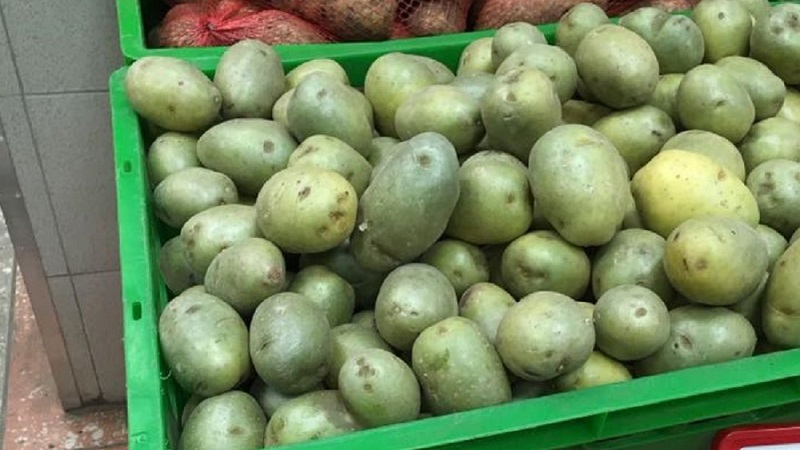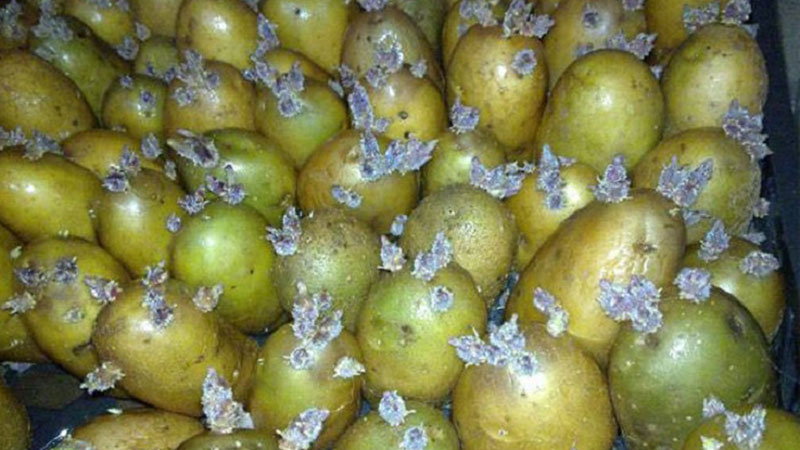Why is solanine in potatoes dangerous?
Potatoes are one of the most famous and popular vegetables in the world. It is grown in 100 countries. About 4,000 potato varieties are known: breeders develop new crops every year. Potatoes are among the world's staples and are used in thousands of different dishes.
However, not everyone knows that this seemingly completely safe and beloved vegetable by many can provoke a severe poisoning with a fatal outcome. For humans, green tubers, which contain large quantities of solanine, are dangerous. Read about why this compound accumulates in green potatoes, how it is dangerous and how to get rid of it, read the article.
The content of the article
What is Solanine
When asked whether it is possible to get poisoned with potatoes, most people will answer negatively without hesitation. And they will be wrong. Poisoning with a vegetable so familiar to us occurs very often and has varying degrees of severity - from mild malaise to disability and even death.
What kind of poison is contained in potatoes? Such a serious danger to humans is posed by a potato alkaloid called solanine.
Solanine is a dangerous and highly toxic plant toxin, a compound of solanidin and glucose. This substance is produced in varying amounts in all plants of the nightshade family.

It is interesting! Solanine is often mispronounced. In fact, the correct spelling of the substance is not difficult to remember: it comes from the Latin name for the Solanaceae family - Solanaceae.
Biologists believe plants produce solanine to ward off microbes, fungi, and insects that eat fruits and leaves. Indeed, when potatoes are planted, greened tubers are more likely to produce healthy offspring.
In potatoes, the highest concentration of solanine is observed in the stem, leaves and berries. If we talk about tubers, then most of the toxin is in the peel, the layer directly under it (as a rule, the maximum thickness of this layer is 1-2 mm), damaged areas, and also in the “eyes” - potato buds.
The most obvious sign of the presence of solanine is green potato color. It indicates that the storage conditions of vegetables were violated. Some people mistakenly believe that it is solanine that gives this color to the tubers, but this is not the case. The poison in green potatoes has no color, and chlorophyll gives it a green tint.... This is an absolutely harmless substance, without which the process of photosynthesis is impossible. However, it is also correct that the most solanine is found in green tubers.
Is it possible to get very poisonous with potatoes

Many people have heard from childhood that you cannot eat green potatoes, but they hardly know how dangerous it is. And it’s hard to believe that such a familiar food can be dangerous. However, this is a confirmed fact.
Since the 19th century, when potatoes became widespread, cases of tuber poisoning have been recorded around the world. For the most part, the symptoms were moderately severe — headache, weakness, nausea with vomiting, and diarrhea. But in some people, the poisoning was extremely severe.
Newspapers and medical journals wrote about both mass and isolated potato poisoning. Symptoms included seizures, paralysis, coma, and volvulus.Some of the victims, including small children, were not saved by doctors.
It is interesting! In 1979, a mass poisoning occurred in a London school for boys. 78 students and several teachers were admitted to the hospital complaining of severe abdominal pain, vomiting and diarrhea. Some had seizures, while others fell into a coma. The audit revealed the cause of the incident. It was a potato stored in the basement of the school for a year.
Now the percentage of fatal poisoning is negligible, since patients receive timely medical care, and the risk of buying poisoned potatoes is low due to the mandatory check of goods entering the stores. But this does not mean that there is no cause for concern.
The effect of solanine on the body

About two hours after eating poisonous potatoes, solanine from the digestive system enters the bloodstream and spreads throughout the body... It is then that toxic damage to the body begins.
The action of solanine is highly dependent on its amount. Small doses of the toxin do not bring tangible harm and can only cause mild discomfort. But the big ones can be extremely dangerous.
Solanine causes the greatest harm to the nervous, respiratory and circulatory systems, as well as the kidneys. Large doses of the toxin suppress the nervous system, destroy red blood cells in the blood, resulting in hemolysis. The blood supply to the kidneys is disrupted and extremely dangerous renal failure occurs.
If the human body is weakened due to illness, pregnancy, old age or too young age, such influences can lead to dire consequences and even death.
It is interesting! You can often observe how raw peeled potatoes, after lying in the air for a while, darken. This is due to the melanin dye. In potatoes, it is formed due to the oxidation of tyrosine and tuber enzymes. This pigment is harmless. The only thing that it affects is the taste and nutritional properties of the product. Therefore, peeled potatoes must be cooked immediately.
Dangerous dosage of solanine
A small amount of solanine in the amount of 20-30 mg is not dangerous. The body successfully breaks it down into harmless components and displays it. A dose of 200-400 mg causes severe intoxication. The characteristic symptoms of acute poisoning appear. Starting from 500 mg, solanine is already deadly even for an adult.
In fresh potatoes, the concentration of this toxin is only 0.05%. It is easy to calculate that in this case a person will be seriously poisoned only if he eats 2-3 kg of green potatoes at a time, which is extremely difficult. But solanine has two unpleasant characteristics.
- The concentration of solanine in potatoes will increase dramatically if stored in the light. In tubers that were kept in a bright room or under the sun for several months, the concentration of the toxin reaches 100-150 mg per 100 g, which is 10 times higher than the safe norm.
- Solanin has a tendency to accumulate. It takes at least 24 hours for the body to break down and remove it.

Poisoning symptoms
Poisoning solanine occurs in the same way and with the same symptoms as any other food intoxication. The only difference is that its symptoms appear 2-3, and sometimes even 8-12 hours after eating. This is due to the fact that doses of solanine, hazardous to health, accumulate in the body gradually.
Signs of solanine poisoning include:
- bitterness and burning in the mouth, sore throat;
- heat;
- dyspnea;
- cardiopalmus;
- dilated pupils;
- lethargy;
- increased salivation;
- stomach cramps;
- bouts of nausea and vomiting;
- diarrhea;
- dizziness and severe headaches;
- drowsiness;
- fainting, convulsions.
In case of severe poisoning, the victim's consciousness is confused, and speech becomes incoherent. Some patients lose consciousness and fall into a coma.All these are signs of depression of the nervous system, which is strongly affected by the toxin.
Depending on the type and strength of symptoms, it is customary to distinguish three degrees of severity of solanine poisoning:
- Light poisoning. It is characterized by digestive upset, severe headache and abdominal pain. The poisoned person is nauseous, vomiting occurs about 3-6 times a day.
- Poisoning of moderate severity... Symptoms are similar to mild poisoning, but much worse. Severe and painful stomach cramps, diarrhea, and very frequent vomiting occur. The poisoned person begins to feel dizzy, blood pressure rises, tachycardia is observed (rapid and uneven heartbeat).
- Severe poisoning. The victim experiences fainting and seizures, heart and kidney function is impaired. The face becomes pale, and the lips become bluish. In severe poisoning, the patient may fall into a coma.
The first signs are nausea, vomiting, abdominal pain and diarrhea. With more severe intoxication, headaches occur, weakness appears throughout the body, the temperature rises, and consciousness may become clouded. This means that the toxin has begun to suppress the nervous system.
First aid

First aid actions depend on the severity of the poisoning. The degree of intoxication is determined so as not to harm the victim and not to miss the symptoms, which require mandatory medical intervention.
In case of mild poisoning, it is quite enough just to take a sorbent, for example, activated carbon or "Smecta", to drink more unsweetened liquid. As a rule, after 1-2 days, the body completely copes with the toxin and removes it.
But if the victim has slurred speech, confused consciousness, impaired coordination, convulsions and constant vomiting with diarrhea, call an ambulance. All these are signs of acute poisoning, and it cannot be treated at home.
Important! Solanine causes the greatest harm to young children, pregnant women, the elderly and people with serious chronic diseases. In case the victim belongs to any of these categories, it is imperative to call a doctor.
Before the arrival of a specialist, you can provide the victim with the following assistance:
- make a gastric lavage and induce vomiting;
- give a sorbent - "Enterosgel", activated carbon or "Smecta";
- drink plenty of water to prevent dehydration.
How to recognize poisonous potatoes
The brightest marker of a poisonous potato is its green color. This is clear evidence that the tubers lay in the sun for a long time and the concentration of the toxin in them increased.
Not only green potatoes can be poisonous, so you need to pay attention not only to the color, but also to the taste of the tubers. If the potato is bitter and, when consumed, begins to sore throat, this is a sure sign of a high concentration of toxin.
Vegetables in which the integrity is violated are also dangerous. As you know, solanine plays a protective function, therefore, when damaged, its concentration increases. Avoid buying tubers that are cracked, cut, or skinned.
Sprouted potatoes are also best discarded. In places where potato buds appear, the amount of solanine always increases, since growth provokes the production of this substance.
The shelf life of potatoes is important. It is desirable that it does not exceed three months. In tubers that have been lying for a longer time, the peel coarsens and thickens, and the amount of toxin increases. Therefore, it is safest to buy prepackaged potatoes, where the harvest date is indicated on the bags.
The concentration of solanine is extremely high in young potatoes, which have not yet matured. Closer to autumn, when the tubers ripen, it decreases. But with long-term storage, the solanine content rises again, and the potatoes that lay until spring-summer become potentially dangerous.

If you grow potatoes yourself, keep an eye on the planting depth and be sure to huddle the plants.If the tubers were planted too close to the surface, some of the potatoes from the new crop may be above the ground and exposed to the sun, which should not be allowed.
Read also:
What to do if the melon is not ripe.
How to store potatoes correctly
The quality and shelf life of potatoes are most influencing the production of solanine in potatoes. It is because of the violation of storage conditions that the toxic substance in green potatoes reaches a concentration that is dangerous to health.
To keep yourself safe, follow these guidelines:
- Do not forget that potatoes are stored in warehouses or shop windows before purchasing. Therefore, it is safest to buy already packaged tubers with the indicated packing date on bags. This eliminates the risk of buying stale vegetables. Try not to buy potatoes from open display cases from street vendors.
- The main factor for the intense production of solanine is sunlight. For this reason, the potatoes are stored in the dark and cool to avoid sprouting. For this, it is preferable to use non-transparent linen bags.
- Inspect stored potatoes periodically. Throw away green and sprouted tubers.
- It is important to remember how long the potatoes have been in storage. In older tubers, the skin becomes thicker and the solanine content underneath increases. Peel off the peel thoroughly, grabbing the layer underneath.
Can I eat cut green potatoes?
In green potatoes, the greatest accumulation of solanine is observed in the peel and "eyes" if it has germinated, which happens quite often.
If you peel the skin thoroughly, cutting the inner layer of the tuber with it, you can get rid of about 80% solanine.
Eating small amounts of potatoes will not cause dangerous consequences. But symptoms can still appear later if, after a few meals, a dangerous amount of toxin accumulates in the body.
The question of whether solanine is destroyed when cooking potatoes is relevant. There is a strong belief that cooking helps to cope with all harmful substances. However, there are a number of dangerous nuances here.
The substance does not dissolve in water, so rinsing will not work. However, when boiling, part of the toxin is released from the root vegetable into the water, and the potatoes become much safer. However, cases of boiled potato poisoning are still common. Therefore, the best way out is to get rid of the green tubers.
Conclusion
The solanine in potatoes is an extremely dangerous compound that can cause serious harm to unwary lovers of this vegetable. However, the risk of poisoning can be reduced to zero if you follow simple rules when storing and eating potatoes.
In no case should you eat green potatoes with sprouted tubers. Observe the storage conditions and keep the potatoes in a dark place where the sun does not penetrate. Try not to buy potatoes from open display cases from street vendors. In this case, you can treat yourself to any potato dishes without any fear.